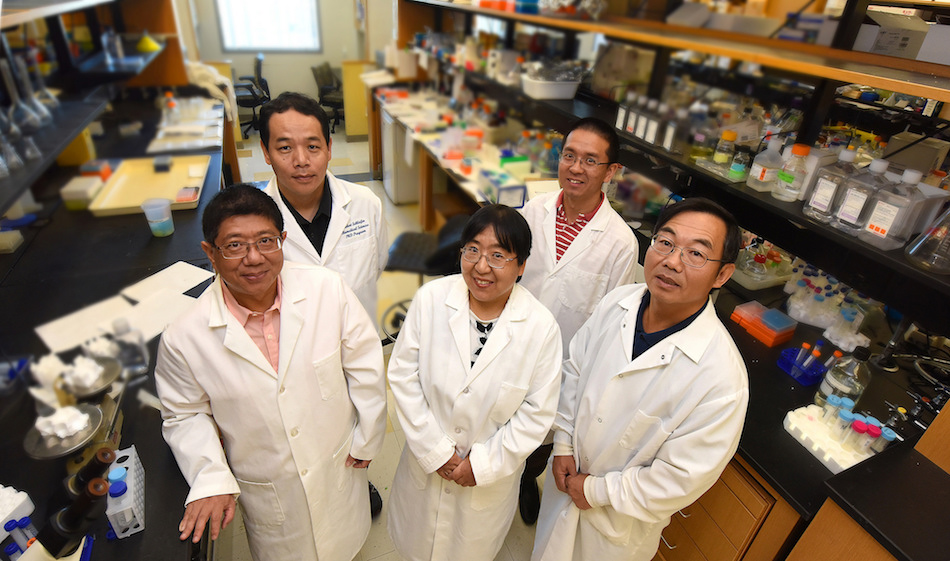Scientists have engineered a sort of biological barbell that can get inside cancer cells and do damage to two proteins that work independently and together to enable cancer’s survival and spread.
Their therapeutic strategy includes a molecule on either end called an aptamer that targets, in this case, prostate cancer. Sandwiched in between are two smaller molecules, called siRNAs, that, once delivered inside the cell, can destroy the messenger RNA making those proteins.
This novel combination of an aptamer on each end with two siRNAs in between also provides a new template for more effective, less toxic gene therapies for a wide range of cancers, like lung and breast cancer, that are common, complex and often deadly, said the research team at the Medical College of Georgia and Georgia Cancer Center at Augusta University.
“With two missiles, the binding power is increased,” said Dr. Hong Yan Liu, immunologist, biochemist and biomedical engineer at MCG’s Center for Biotechnology and Genomic Medicine. “It’s also a way to get more siRNA to and inside the cell,” said the corresponding author of the study in the journal Scientific Reports.
Giving the therapeutic system two arms – like the antibodies the body makes to defend against invaders – definitely gives it a better hold on its cancer target, said Dr. Jin-Xiong She, director of the Center for Biotechnology and Genomic Medicine and Georgia Research Alliance Eminent Scholar in Genomic Medicine.
Liu used a three-dimensional aptamer targeting prostate-specific membrane antigen, or PSMA, which is overexpressed on the surface of and inside prostate cancer cells, to help the siRNA find and enter the cancer cells.
“We then targeted two tumor-dependent genes,” said Liu. She is talking about epidermal growth factor receptor, or EGFR, and the aptly named survivin gene – since it prevents cells from committing suicide. Overexpression of EGFR is associated with prostate cancer that is resistant to current treatment strategies and prone to spreading to the bone. Survivin overexpression also is associated with treatment resistance, recurrence and disease spread.
While the two function independently, they also can partner, sharing several signaling pathways. In fact, when EGFR inhibitors have been used previously, tumors may switch to the survivin pathway for survival.
But the simultaneous attack on both by the scientists translated to suppressing the growth of cancer and the blood vessels it needs to survive in models where human prostate cancer cells were placed in immunodeficient mice and human cells were treated in a dish. Their model mimics middle-to-late stage prostate cancers, which is when this most common cancer in American males is diagnosed and when many existing therapies don’t work.
The small interfering RNAs, or siRNAs, used to interrupt EGFR and survivin’s support of prostate cancer have potential for “undruggable” cancer targets and there are plenty of them, said Dr. Daqing Wu, study co-author and cancer biologist at the Georgia Cancer Center and in the MCG Department of Biochemistry and Molecular Biology.
Many of these cancer promoters hide inside cells where many drugs can’t reach. Receptors on the cells surface, including EGFR, are considered “druggable,” Wu said. Still monoclonal antibody drugs already in use typically bind to the outside-membrane part of receptors, and while they are specific, they can’t get inside cells where proteins like survivin also are found, Wu said. Small molecule drugs can get inside cells but typically lack specificity, which reduces their effectiveness and increases side effects. “This kind of delivery system is more practical for targeting undruggable targets,” Wu said.
Cancer requires certain proteins to survive and proliferate that typically are different from healthy cells or, at least, present at much higher levels. “With this approach, you can specifically target the proteins that cancer cells are addicted to,” She said.
DNA- or RNA-based therapies stop or reduce excessive production of these proteins most typically by blocking or reducing gene expression or production of the messenger RNA that ultimately makes the proteins.
“When you stop protein production, cancer cells will divide and die,” She said. Like other approaches, this one isn’t perfect since, for example, the synthetically produced siRNA can degrade rapidly and needs clear directions to find the target messenger RNA inside cancer cells.
Next steps, which are underway, include identifying missiles and protein targets for other cancers and more for prostate cancer as well. Cancers, particularly at advanced stages, become more heterogeneous, meaning they utilize more pathways to survive and thrive, which is why most current treatments are combinations of drugs and targets. Pathways and proteins can even vary from one patient to the next with the same type of cancer, so finding multiple proteins for targeting enhances efficacy, Wu said.
The research was funded by the Department of Defense and the National Cancer Institute.
DOWNLOADS: High-resolution photo of, from left, Drs. Jin-Xiong She, Daqing Wu, Hong Yan Liu, Haitao Liu and Xiaolin Yu
 Augusta University
Augusta University




